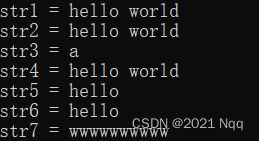黑马C++ 03 提高4 —— STL常用容器_string容器/vector容器/deque容器
文章目录
- 一、string容器
-
- 1. string基本概念
- 2. string构造函数
- 3. string赋值操作
- 4. string字符串拼接
- 5. string查找和替换
- 6. string字符串比较
- 7. string字符存取
- 8. string字符串的插入和删除
- 9. string子串
- 二、vector容器(尾插尾删)
-
- 1. vector基本概念
- 2. vector构造函数
- 3. vector赋值操作
- 4. vector容量与大小
- 5. vector插入和删除
- 6. vector数据存取
- 7. vector互换容器
- 8. vector预留空间
- 三、deque容器(双端数组)
-
- 1. deque基本概念
- 2. deque构造函数(必须使用const只读迭代器)
- 3. deque赋值操作
- 4. deque大小操作(没有容量说法只有个数)
- 5. deque插入和删除
- 6. deque数据存取
- 7. deque排序
- 四、案例 —— 评委打分
-
- 1 案例描述
- 2 实现步骤
一、string容器
1. string基本概念
本质:string是C++风格的字符串,而string本质上是一个类。
string和char * 区别:
- char * 是一个指针
- string是一个类,类内部封装了char*,管理这个字符串,是一个char*型的容器。
特点:
- string 类内部封装了很多成员方法,例如:查找 find,拷贝 copy,删除 delete,替换 replace,插入insert。
- string管理char*所分配的内存,不用担心复制越界和取值越界等,由类内部进行负责
2. string构造函数
构造函数原型:
string();创建一个空的字符串 例如: string strstring(const char* s);使用字符串s初始化string(const string& str);使用一个string对象初始化另一个string对象string(int n, char c);使用n个字符c初始化
#include- 总结:string的多种构造方式没有可比性,灵活使用即可
3. string赋值操作
功能描述:
- 给string字符串进行赋值
赋值的函数原型:
string& operator=(const char* s);char*类型字符串 赋值给当前的字符串string& operator=(const string &s);把字符串s赋给当前的字符串string& operator=(char c);字符赋值给当前的字符串string& assign(const char *s);把字符串s赋给当前的字符串string& assign(const char *s, int n);把字符串s的前n个字符赋给当前的字符串string& assign(const string &s);把字符串s赋给当前字符串string& assign(int n, char c);用n个字符c赋给当前字符串
总结:string的赋值方式很多,operator= 这种方式是比较实用的
#include4. string字符串拼接
功能描述:
- 实现在字符串末尾拼接字符串
函数原型:
string& operator+=(const char* str);重载+=操作符string& operator+=(const char c);重载+=操作符string& operator+=(const string& str);重载+=操作符string& append(const char *s);把字符串s连接到当前字符串结尾string& append(const char *s, int n);把字符串s的前n个字符连接到当前字符串结尾string& append(const string &s);同operator+=(const string& str)string& append(const string &s, int pos, int n);字符串s中从pos开始的n个字符连接到字符串结尾
#include5. string查找和替换
功能描述:
- 查找:查找指定字符串是否存在
- 替换:在指定的位置替换字符串
函数原型:
int find(const string& str, int pos = 0) const;查找str第一次出现位置,从pos开始查找int find(const char* s, int pos = 0) const;查找s第一次出现位置,从pos开始查找int find(const char* s, int pos, int n) const;从pos位置查找s的前n个字符第一次位置int find(const char c, int pos = 0) const;查找字符c第一次出现位置int rfind(const string& str, int pos = npos) const;查找str最后一次位置,从pos开始查找int rfind(const char* s, int pos = npos) const;查找s最后一次出现位置,从pos开始查找int rfind(const char* s, int pos, int n) const;从pos查找s的前n个字符最后一次位置int rfind(const char c, int pos = 0) const;查找字符c最后一次出现位置string& replace(int pos, int n, const string& str);替换从pos开始n个字符为字符串strstring& replace(int pos, int n,const char* s);替换从pos开始的n个字符为字符串s
#include6. string字符串比较
功能描述:
- 字符串之间的比较
比较方式:
- 字符串比较是按字符的ASCII码进行对比
= 返回 0
> 返回 1
< 返回 -1
函数原型:
-
int compare(const string &s) const;与字符串s比较 -
int compare(const char *s) const;与字符串s比较 -
总结:字符串对比主要是用于比较两个字符串是否相等,判断谁大谁小的意义并不是很大
#include7. string字符存取
string中单个字符存取方式有两种
char& operator[](int n);通过[]方式取字符char& at(int n);通过at方法获取字符
总结
- string字符串中单个字符存取有两种方式,利用 [ ] 或 at
#include8. string字符串的插入和删除
功能描述:
- 对string字符串进行插入和删除字符操作
函数原型:
string& insert(int pos, const char* s);插入字符串string& insert(int pos, const string& str);插入字符串string& insert(int pos, int n, char c);在指定位置插入n个字符cstring& erase(int pos, int n = npos);删除从Pos开始的n个字符
总结
- 插入和删除的起始下标都是从0开始
#include9. string子串
功能描述:
- 从字符串中获取想要的子串
函数原型:
string substr(int pos = 0, int n = npos) const;返回由pos开始的n个字符组成的字符串
#include二、vector容器(尾插尾删)
1. vector基本概念
功能:
- vector数据结构和数组非常相似,也称为单端数组
vector与普通数组区别:
- 不同之处在于数组是静态空间,而vector可以动态扩展
动态扩展:
- 并不是在原空间之后续接新空间,而是找更大的内存空间,然后将原数据拷贝新空间,释放原空间
- vector容器的迭代器是支持随机访问的迭代器
- 尾插和尾删,常用v.begin()和v.end()。
2. vector构造函数
功能描述:
- 创建vector容器
函数原型:
vector采用模板实现类实现,默认构造函数v; vector(v.begin(), v.end());将v[begin(), end())区间中的元素拷贝给本身,前闭后开vector(n, elem);构造函数将n个elem拷贝给本身。vector(const vector &vec);拷贝构造函数。
#include3. vector赋值操作
功能描述:
- 给vector容器进行赋值
函数原型:
vector& operator=(const vector &vec);重载等号操作符assign(beg, end);将[beg, end)区间中的数据拷贝赋值给本身。assign(n, elem);将n个elem拷贝赋值给本身
#include4. vector容量与大小
功能描述:
- 对vector容器的容量和大小操作
函数原型:
empty();判断容器是否为空capacity();容器的容量size();返回容器中元素的个数resize(int num);重新指定容器的长度为num,若容器变长,则以默认值填充新位置。如果容器变短,则末尾超出容器长度的元素被删除。resize(int num, elem);重新指定容器的长度为num,若容器变长,则以elem值填充新位置。如果容器变短,则末尾超出容器长度的元素被删除。
总结:
- 判断是否为空 — empty
- 返回元素个数 — size
- 返回容器容量 — capacity
- 重新指定大小 — resize
#include5. vector插入和删除
功能描述:
- 对vector容器进行插入、删除操作
函数原型:
push_back(ele);尾部插入元素elepop_back();删除最后一个元素insert(const_iterator pos, ele);迭代器指向位置pos插入元素eleinsert(const_iterator pos, int count,ele);迭代器指向位置pos插入count个元素eleerase(const_iterator pos);删除迭代器指向的元素erase(const_iterator start, const_iterator end);删除迭代器从start到end之间的元素clear();删除容器中所有元素
#include6. vector数据存取
功能描述:
- 对vector中的数据的存取操作
函数原型:
at(int idx);返回索引idx所指的数据operator[];返回索引idx所指的数据front();返回容器中第一个数据元素back();返回容器中最后一个数据元素
#include7. vector互换容器
功能描述:
- 实现两个容器内元素进行互换
函数原型:
swap(vec);将vec与本身的元素互换
总结:
#include8. vector预留空间
功能描述:
- 减少vector在动态扩展容量时的扩展次数
函数原型:
- 每次分配的内存满后就会重新分配内存,p指向新分配的内存的首地址。使用reserve预留空间
#include三、deque容器(双端数组)
1. deque基本概念
功能:
- 双端数组,可以对头端进行插入删除操作
deque与vector区别:
- vector对于头部的插入删除效率低,数据量越大,效率越低
- deque相对而言,对头部的插入删除速度回比vector快
- vector访问元素时的速度会比deque快,这和两者内部实现有关
- 头部尾部的插入删除快,但访问数据效率低,因为需要重新找缓存区的地址,然后再进行访问

- deque内部有个中控器,维护每段缓冲区中的内容,缓冲区中存放真实数据
- 中控器维护的是每个缓冲区的地址,使得使用deque时像一片连续的内存空间
- deque容器的迭代器也是支持随机访问的
2. deque构造函数(必须使用const只读迭代器)
功能描述:
- deque容器构造
函数原型:
dequedeqT; 默认构造形式deque(beg, end);构造函数将[beg, end)区间中的元素拷贝给本身。deque(n, elem);构造函数将n个elem拷贝给本身。deque(const deque &deq);拷贝构造函数
#include3. deque赋值操作
功能描述:
- 给deque容器进行赋值
函数原型:
deque& operator=(const deque &deq);重载等号操作符assign(beg, end);将[beg, end)区间中的数据拷贝赋值给本身。assign(n, elem);将n个elem拷贝赋值给本身。
#include4. deque大小操作(没有容量说法只有个数)
功能描述:
- 对deque容器的大小进行操作
函数原型:
deque.empty();判断容器是否为空deque.size();返回容器中元素的个数deque.resize(num);重新指定容器的长度为num,若容器变长,则以默认值填充新位置。如果容器变短,则末尾超出容器长度的元素被删除deque.resize(num, elem);重新指定容器的长度为num,若容器变长,则以elem值填充新位置。如果容器变短,则末尾超出容器长度的元素被删除
#include5. deque插入和删除
功能描述:
- 向deque容器中插入和删除数据
函数原型
两端插入操作:
push_back(elem);在容器尾部添加一个数据push_front(elem);在容器头部插入一个数据pop_back();删除容器最后一个数据pop_front();删除容器第一个数据
指定位置操作:
insert(pos,elem);在pos位置插入一个elem元素的拷贝,返回新数据的位置。insert(pos,n,elem);在pos位置插入n个elem数据,无返回值。insert(pos,beg,end);在pos位置插入[beg,end)区间的数据,无返回值。clear();清空容器的所有数据erase(beg,end);删除[beg,end)区间的数据,返回下一个数据的位置。erase(pos);删除pos位置的数据,返回下一个数据的位置。
总结:
- 插入和删除提供的位置是迭代器!
- 尾插 — push_back
- 尾删 — pop_back
- 头插 — push_front
- 头删 — pop_front
#include6. deque数据存取
功能描述:
- 对deque 中的数据的存取操作
函数原型:
at(int idx);返回索引idx所指的数据operator[];返回索引idx所指的数据front();返回容器中第一个数据元素back();返回容器中最后一个数据元素
总结:
- 除了用迭代器获取deque容器中元素,[ ]和at也可以
- front返回容器第一个元素
- back返回容器最后一个元素
#include7. deque排序
功能描述:
- 利用算法实现对deque容器进行排序
算法:
sort(iterator beg, iterator end)对beg和end区间内元素进行排序
总结:
- sort算法非常实用,使用时包含头文件 algorithm即可
#include四、案例 —— 评委打分
1 案例描述
- 有5名选手:选手ABCDE,10个评委分别对每一名选手打分,去除最高分,去除评委中最低分,取平均分。
2 实现步骤
- 创建五名选手,放到vector中
- 遍历vector容器,取出来每一个选手,执行for循环,可以把10个评分打分存到deque容器中
- sort算法对deque容器中分数排序,去除最高和最低分
- deque容器遍历一遍,累加总分
- 获取平均分
#include::iterator it = v.begin(); it != v.end(); it++)
{
cout << "姓名:" << (*it).m_Name << "分数:" << (*it).m_Score << endl;
}*/
// 2.给5名选手打分
createScore(v);
// 3.显示最后得分
showScore(v);
system("pause");
return 0;
}























